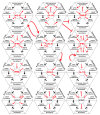Cytokine-Targeted Therapeutics for KSHV-Associated Disease
- PMID: 32998419
- PMCID: PMC7600567
- DOI: 10.3390/v12101097
Cytokine-Targeted Therapeutics for KSHV-Associated Disease
Abstract
Kaposi's sarcoma-associated herpesvirus (KSHV) also known as human herpesvirus 8 (HHV-8), is linked to several human malignancies including Kaposi sarcoma (KS), primary effusion lymphoma (PEL), multicentric Castleman's disease (MCD) and recently KSHV inflammatory cytokine syndrome (KICS). As with other diseases that have a significant inflammatory component, current therapy for KSHV-associated disease is associated with significant off-target effects. However, recent advances in our understanding of the pathogenesis of KSHV have produced new insight into the use of cytokines as potential therapeutic targets. Better understanding of the role of cytokines during KSHV infection and tumorigenesis may lead to new preventive or therapeutic strategies to limit KSHV spread and improve clinical outcomes. The cytokines that appear to be promising candidates as KSHV antiviral therapies include interleukins 6, 10, and 12 as well as interferons and tumor necrosis factor-family cytokines. This review explores our current understanding of the roles that cytokines play in promoting KSHV infection and tumorigenesis, and summarizes the current use of cytokines as therapeutic targets in KSHV-associated diseases.
Keywords: KSHV; cytokine signaling; cytokine targeted therapy; cytokine therapeutics; immunomodulatory therapeutics; pathogenesis.
Conflict of interest statement
The authors declare no conflict of interest. The funders had no role in the design of the study; in the collection, analyses, or interpretation of data; in the writing of the manuscript, or in the decision to publish the results.
Figures
Similar articles
-
Recent Advances in Developing Treatments of Kaposi's Sarcoma Herpesvirus-Related Diseases.Viruses. 2021 Sep 9;13(9):1797. doi: 10.3390/v13091797. Viruses. 2021. PMID: 34578378 Free PMC article. Review.
-
Linking KSHV to human cancer.Curr Oncol Rep. 2005 Sep;7(5):349-56. doi: 10.1007/s11912-005-0061-6. Curr Oncol Rep. 2005. PMID: 16091195 Review.
-
Pathological Features of Kaposi's Sarcoma-Associated Herpesvirus Infection.Adv Exp Med Biol. 2018;1045:357-376. doi: 10.1007/978-981-10-7230-7_16. Adv Exp Med Biol. 2018. PMID: 29896675 Review.
-
Molecular Biology of KSHV in Relation to HIV/AIDS-Associated Oncogenesis.Cancer Treat Res. 2019;177:23-62. doi: 10.1007/978-3-030-03502-0_2. Cancer Treat Res. 2019. PMID: 30523620 Free PMC article.
-
[Replication Machinery of Kaposi's Sarcoma-associated Herpesvirus and Drug Discovery Research].Yakugaku Zasshi. 2019;139(1):69-73. doi: 10.1248/yakushi.18-00164-2. Yakugaku Zasshi. 2019. PMID: 30606932 Review. Japanese.
Cited by
-
Targeting Kaposi's sarcoma associated herpesvirus encoded protease (ORF17) by a lysophosphatidic acid molecule for treating KSHV associated diseases.Front Cell Dev Biol. 2023 Jan 17;11:1060156. doi: 10.3389/fcell.2023.1060156. eCollection 2023. Front Cell Dev Biol. 2023. PMID: 36733461 Free PMC article.
-
Human Gammaherpesvirus 8 Oncogenes Associated with Kaposi's Sarcoma.Int J Mol Sci. 2022 Jun 29;23(13):7203. doi: 10.3390/ijms23137203. Int J Mol Sci. 2022. PMID: 35806208 Free PMC article. Review.
-
miR-769-3p inhibits cellular proliferation of KSHV-infected SH-SY5Y cells through targeting mTOR.J Cancer. 2024 Apr 23;15(11):3338-3349. doi: 10.7150/jca.93595. eCollection 2024. J Cancer. 2024. PMID: 38817860 Free PMC article.
-
Molecular Virology of KSHV in the Lymphocyte Compartment-Insights From Patient Samples and De Novo Infection Models.Front Cell Infect Microbiol. 2020 Dec 4;10:607663. doi: 10.3389/fcimb.2020.607663. eCollection 2020. Front Cell Infect Microbiol. 2020. PMID: 33344267 Free PMC article. Review.
-
Targeted delivery of miR-34a-5p by phenylborate-coupled polyethylenimide nanocarriers for anti-KSHV treatment.Front Bioeng Biotechnol. 2024 Jan 8;11:1343956. doi: 10.3389/fbioe.2023.1343956. eCollection 2023. Front Bioeng Biotechnol. 2024. PMID: 38260739 Free PMC article.
References
-
- Soulier J., Grollet L., Oksenhendler E., Cacoub P., Cazals-Hatem D., Babinet P., d’Agay M., Clauvel J.-P., Raphael M., Degos L. Kaposi’s sarcoma-associated herpesvirus-like DNA sequences in multicentric Castleman’s disease [see comments] Blood. 1995;86:1276–1280. doi: 10.1182/blood.V86.4.1276.bloodjournal8641276. - DOI - PubMed
-
- Uldrick T.S., Wang V., O’Mahony D., Aleman K., Wyvill K.M., Marshall V., Steinberg S.M., Pittaluga S., Maric I., Whitby D. An interleukin-6-related systemic inflammatory syndrome in patients co-infected with Kaposi sarcoma-associated herpesvirus and HIV but without Multicentric Castleman disease. Clin. Infect. Dis. 2010;51:350–358. doi: 10.1086/654798. - DOI - PMC - PubMed
Publication types
MeSH terms
Substances
Supplementary concepts
Grants and funding
LinkOut - more resources
Full Text Sources
Medical
Research Materials


